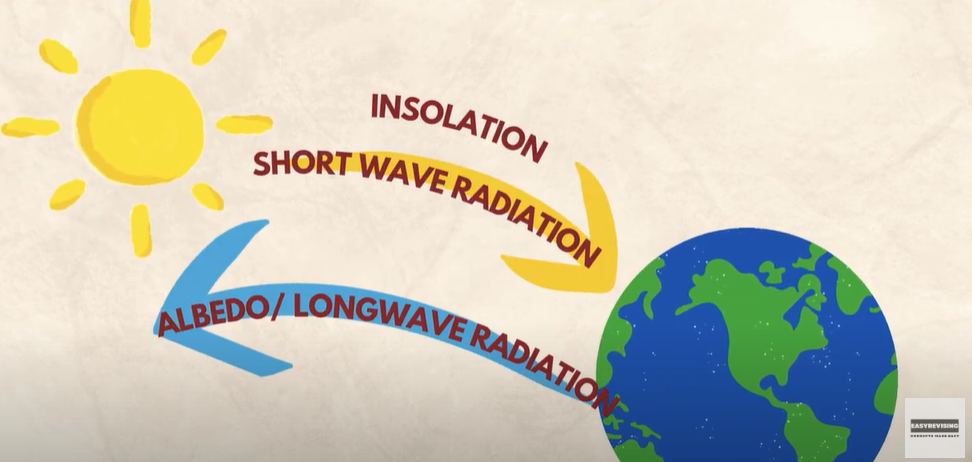The Earth’s energy atmospheric budget is a key concept in IB Geography. This budget explains how solar radiation (insolation) enters Earth’s system and how heat energy leaves it. A stable energy budget maintains our climate, so understanding how this balance works is essential for explaining weather, climate change, and energy flows in the Earth-atmosphere system.
Energy Atmospheric Budget Explained
The atmospheric energy budget refers to how energy from the Sun is absorbed as input, reflected by albedo, and emitted by the Earth back to the atmosphere as longwave radiation.
It’s a delicate balance — too much incoming solar radiation, and the planet heats up; too much outgoing energy, and it cools.

A lot of my students tell me they shut down when they hear “longwave” v “shortwave” radiation. It may seem worryingly technical, but fret not. As a student, I’d remember shortwave radiation being from the sun (both starting with “s”), while longwave radiation being what earth reflects back to the atmosphere, that “travels a long way” lol.
Key Processes Affecting the Energy Budget
Here are the key factors that impact the energy balance — and what you should know for IB exams:
1. Insolation (Incoming Solar Radiation)
Insolation is the amount of solar energy received by a given area. It varies with latitude, time of year, and cloud cover.
2. Albedo Effect
In IB Geography, albedo refers to the amount of solar radiation reflected by a surface. Lighter surfaces like snow and ice have a high albedo because they reflect most sunlight, while darker surfaces like forests or roads have a low albedo, meaning they absorb more heat.
3. Greenhouse Effect
Greenhouse gases (GHGs) like CO₂, CH₄, and water vapor trap some of the outgoing longwave radiation, keeping the planet warm. Without GHGs, Earth’s average temperature would be around -18°C, instead of the current +15°C.
4. Global Dimming
Global dimming refers to a reduction in solar radiation reaching Earth’s surface, often caused by air pollution, volcanic eruptions, and aerosols. It reduces the effectiveness of insolation and affects weather patterns.
Input, Absorption and Output
Inputs (into the earth’s system): Insolation, also known as shortwave radiation, is the solar energy that reaches the Earth’s surface. This energy drives weather patterns, climate, and life itself.
Not all of it reaches the earth though. Some energy is absorbed or reflected before reaching the ground:
- Absorbed by atmosphere (ie. ozone, dust, water vapour)
- Reflected by clouds (contributing to albedo)
- Reflected by Earth’s surface (especially ice, snow, deserts)
When it reaches earth, greenhouse gases (GHGs) are atmospheric gases that absorb the shortwave radiation, trapping heat within the Earth’s atmosphere. Key GHGs include carbon dioxide (CO₂), methane (CH₄), nitrous oxide (N₂O), and water vapor (H₂O). They play a crucial role in maintaining Earth’s temperature through the natural greenhouse effect.
The Earth, may absorb some of this heat, while some is trapped in our greenhouse gases, but the rest? Output.
Heat (output leaving the earth) is emitted back into space as longwave radiation. The balance between incoming shortwave and outgoing longwave radiation regulates the planet’s temperature.
Factors influencing the amount of insolation
- The angle at which the Sun’s rays strike the Earth (the poles get less insolation compared to the equator)
- Duration of daylight, which is an obvious one, the longer the days, the larger amount of insolation
- Sunspots are dark patches on the Sun’s surface, often surrounded by bright, hot areas known as faculae. Their numbers fluctuate in an approximately 11-year cycle. During periods with more sunspots, solar activity intensifies, resulting in increased shortwave radiation reaching Earth’s atmosphere
- Albedo refers to the percentage of solar radiation reflected by the Earth’s surface. Increased cloud cover reflects more sunlight back into space and limiting the amount of sunlight absorbed by Earth
- Global dimming, a phenomenon where less solar radiation reaches Earth’s surface due to aerosols, pollutants, or volcanic ash scattering and absorbing sunlight.
A striking example is the 1991 eruption of Mount Pinatubo in the Philippines, which released millions of tons of sulfur dioxide, creating a sulfate aerosol layer that cooled the Earth’s surface by about 0.5°C for up to two years.
Read here for more on Feedback Loops
Read here for more on Impacts of Global Warming
Full Global Climate Revision Pack available
